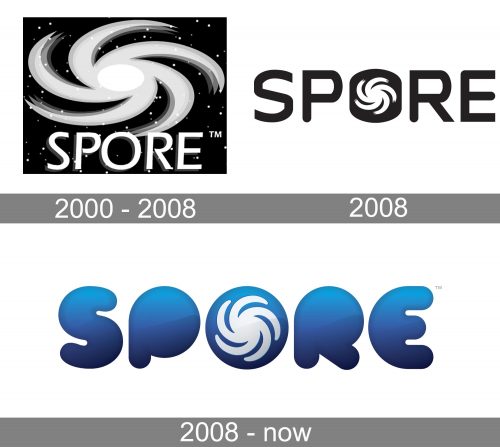Spore is among the world’s best-known simulation strategy God games. It has something from many genres, from action to real-time strategy and RPG.
Meaning and history
While Spore was officially released only in 2008, the work on the project started a lot earlier, and there had been multiple delays.
2000 — 2008 (Spore)
The concept logo was performed in black and white. It already featured the swirling light shape that has been part of the core of the Spore logo ever since.
The swirling light dominated the design, while the name of the brand could be seen below. It was executed in a rather light all-caps sans. The background featured the night sky.
2008
The authors of the beta-logo made the swirl smaller and placed it inside the solid black “O.” Thus, the swirl replaced the gap inside the “O.”
The other letters were of the same height as the “O” but possessed a more traditional shape. While it was slightly different than the shape of the glyphs on the previous logo, the overall style has remained the same. The letters still had traditional proportions and belonged to an all-caps sans. The most memorable part of the design, apart from the central glyph, was the unusual green background. There was plenty of gradient and shades of all kinds. The background was apparently inspired by the probably most influential theory of the birth of life on Earth, according to which the first micro-organisms appeared in the primordial soup of organic chemicals.
2008 — now
The green logo, however, was soon replaced by a very different one. Here, the main color, the color of the letters, was blue, with a pronounced gradient.
The thin letters became very plump, with rounded ends. The “O” still houses the swirl of light, which now occupies more space inside the letter. The “O,” in its turn, is now a perfect circle. The circular theme is strongly supported by the two nearest glyphs, the “P” and “R” – their tops are small circles.
Font
The custom type looks unique and friendly, due to the rounded shapes. None of the letters have serifs.
Colors
The blue color is typically associated with the ocean and the sky. The ocean interpretation appears more natural in the Spore logo, to create the link with the “primordial soup,” in which the first organisms appeared. The gradient, which goes from the darker lower part to the lighter top, seems to support the ocean interpretation, as the water at the top layers of the ocean contains more light. Also, it can be interpreted as the symbol of the universe and its unlimited possibilities.











